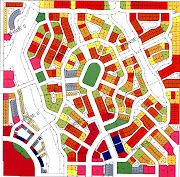And How Did Things Get to Be that Big Anyway?
To refresh this blog, click here: http://www.newherbanism.blogspot.com/
There is a growing consciousness in the country that a lot of things need to shrink. A lot of things have gotten to be just too big. Look around and you will see the proof everywhere . . . from the size of our food portions to the proportions of our homes.
Since 1987 the diameter of an ordinary bagel has ballooned 3 inches and the calorie count has jumped a whopping 250% percent from 140 to 350. The average cookie has increased from 1.5 inches to 3.5 inches. Muffins have mushroomed from 1.5 ounces to 4.5 ounces while French fries have been supersized from 2.4 ounces to 6.9 ounces.
But that is just food. Look at what has happened to the size of our houses. For each year below the average square footage of a new home built that year is shown:
1950......983
1970....1,500
1990....2,080
2004....2,349
See my post of March 29th for a more in-depth discussion of this phenomenon.
Can things continue to grow bigger and bigger relentlessly forever? More and more people are concluding that they cannot. At the fifteenth annual meeting of the Congress for the New Urbanism in Philadelphia last week, there was evident a growing consensus that a lot of things have to get smaller and get smaller fast.
We need to have a smaller carbon foot print to have any hope at all of slowing the course of global climate change. That means smaller, more energy efficient cars, more reliance on mass transit and increased use of alternate modes of transportation ranging from the bicycle to good, old fashioned walking. It means smaller houses too. It means green building and it means smart growth and new urbanism and traditional neighborhood development.
The growing series of books that started with Sarah Susanka’s The Not So Big House (see http://www.notsobighouse.com/) and the rapidly rising popularity of the Katrina Cottages originally designed by Marianne Cusato (see http://www.cusatocottages.com/) now being marketed in kit form by Lowe’s are but a few of the clues that the movement to get smaller is getting bigger.
From the size of the food portions we eat to the size of houses we live in and every thing in between, it is time now to reassess just how much “Bigness” we can take. Small is the next Big.
Be sure to visit the website for Omaha's first new traditional neighborhood: http://www.whatsnewonstatestreet.com/.
Click here to see the site plan : http://www.whatsnewonstatestreet.com/info/day_06siteplan.html and notice the variety of lot types that will accommodate the smaller dwelling unit. In Omaha’s first new traditional neighborhood development (called for short a "TND"), you will find row house lots, live/work lots, cottage lots, village lots and accessory dwelling units over garages in the alleys. All of these, plus apartment flats in apartment mansions and over retail spaces, will offer the choices for smaller houses and dwelling units that people are seeking in bigger numbers.
Wednesday, May 23, 2007
Subscribe to:
Comments (Atom)


